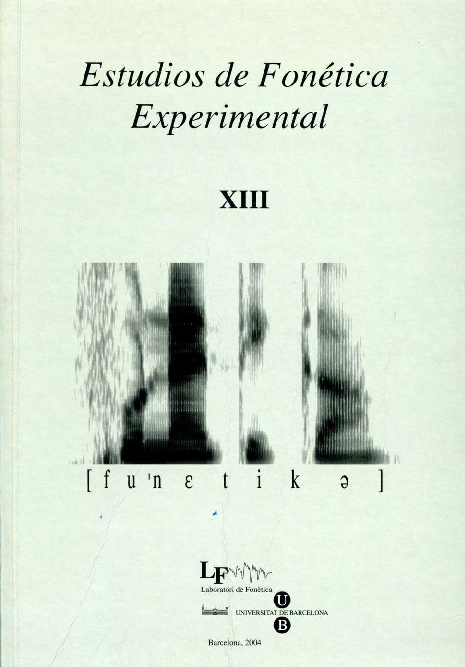An acoustic and statistical analysis of Spanish mid–vowel allophones
Abstract
In 1918 Navarro Tomás claimed that Spanish mid vowels have open and close allophones. Whilst some acoustic studies have supported these claims, others have not. The conclusions in these studies were subjective since they failed to apply statistical analysis to the acoustic data. Statistical analysis is required to determine whether data with a range of values can be grouped into distinct categories. The present study investigates the production of Spanish /e/ and /o/ in several contexts in which Navarro Tomás claimed open and close allophones would be found. Recordings were made of a male and a female speaker of educated Madrid Spanish, the dialect which Navarro Tomás originally described. First and second formants were measured and statistically analysed. Formant frequencies did not cluster into two groups associated with the contexts in which Navarro Tomás claimed each allophone would occur. Other potential allophones were identified: fronted and retracted allophones for /o/; and close-fronted, central, and open- retracted allophones for /e/.
References
ALARCOS LLORACH, E. (1965): Fonología Española (4th ed.), Madrid, Gredos.
BROWN, M. T. and L.R. WICKER (2000): «Discriminant analysis», in H. Tinsley and S. Brown (eds.): Handbook of Applied Multivariate Statistics and Mathematical Modeling, San Diego, Academic Press, pp. 209–235.
BOERSMA, P. and D. WEENINK (2000): Praat (version 3.9) [Computer software], Amsterdam, Authors.
CÁRDENAS, D. C. (1960): «Acoustic vowel loops of two Spanish idiolects», Phonetica, 5, pp. 9–34.
CHIBA, T. and M. KAJIYAMA (1941): The Vowel: Its Nature and Structure, Tokyo, Tokyo-Kaiseikan.
ESSNER, C. (1947): «Recherche sur la structure des voyelles orales», Archives Néerlandaises de Phonétique Expérimentale, 20, pp.40–77.
HARRINGTON, J. and S. CASSIDY (1999): Techniques in Speech Acoustics, Dordrecht, Kluwer Academic Publishers.
JOHNSTON, D. (1999): Cool Edit Pro LE (version 1.2) [Computer software], Phoenix, AZ, Syntrillium.
JOOS, M. (1948): Acoustic Phonetics, Baltimore, Linguistic Society of America.
KLECKA, W. R. (1980): Discriminant Analysis, Beverly Hills, CA and London, Sage Publications.
MARTÍNEZ CELDRÁN, E. (1984): «Cantidad e intensidad en los sonidos obstruyentes del castellano: Hacia una caracterización acústica de los sonidos aproximantes», Estudios de fonética experimental, 1, pp. 73–129.
MARTÍNEZ CELDRÁN, E. (1994): Fonética (4th ed.), Barcelona, Teide.
NAVARRO TOMÁS, T. (1918): Manual de pronunciación española, Madrid: CSIC, 1965 (12th ed.).
NAVARRO TOMÁS, T. (1960): Review of «Acoustic vowel loops of two Spanish idiolects», Nueva Revista Filológica Hispánica, 14, pp. 342–345.
NEAREY, T. M. (1978): Phonetic Feature Systems for Vowels, Bloomington, IN, Indiana University Linguistics Club.
ROMESBURG, H. C. (1984): Cluster Analysis for Researchers, Belmont, CA, Lifetime Learning Publications.
SKELTON, R. (1969): «The pattern of Spanish vowel sounds», International Review of Applied Linguistics, 7, pp. 231–237.
SPSS INC. (1999): SPSS Base 10.0 Applications Guide, Chicago, Author.
STEVENS, J. P. (2002): Applied Multivariate Statistics for the Social Sciences (4th ed.), Mahwah, NJ, Lawrence Erlbaum Associates.
TATSUOKA, M. T. (1970): Discriminant Analysis: The study of Group Differences, Champaign, IL, Institute for Personality and Ability Testing.
Downloads
Published
How to Cite
Issue
Section
License

This work is licensed under a Creative Commons Attribution-NonCommercial-NoDerivatives 4.0 International License.
All articles published online by Estudios de Fonética Experimental are licensed under Creative Commons Attribution-NonCommercial-NoDerivs 4.0 International (CC BY-NC-ND 4.0 DEED), unless otherwise noted. Estudios de Fonética Experimental is an open access journal. Estudios de Fonética Experimental is hosted by RCUB (Revistes Científiques de la Universitat de Barcelona), powered by Open Journal Systems (OJS) software. The copyright is not transferred to the journal: authors hold the copyright and publishing rights without restrictions. The author is free to use and distribute pre and post-prints versions of his/her article. However, preprint versions are regarded as a work-in-progress version used as internal communication with the authors, and we prefer to share postprint versions.




